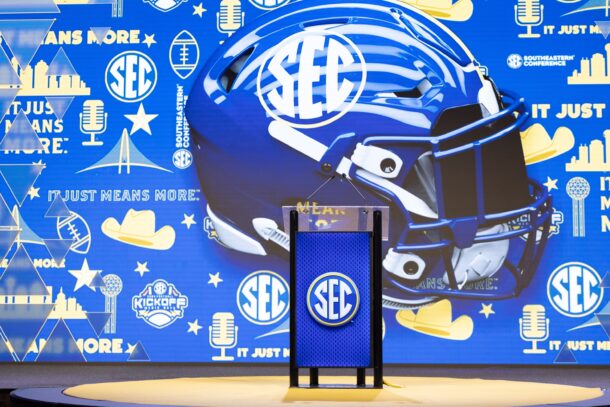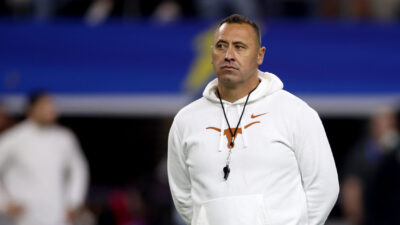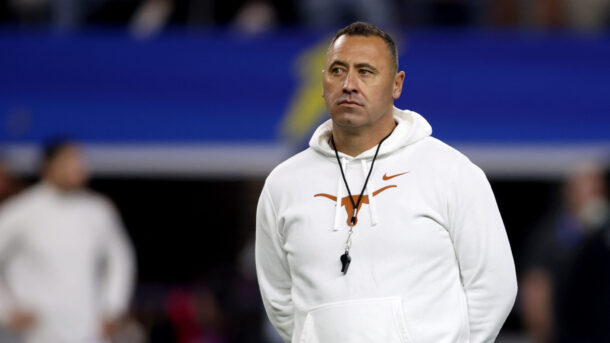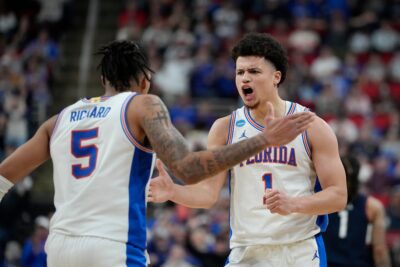Ad Disclosure
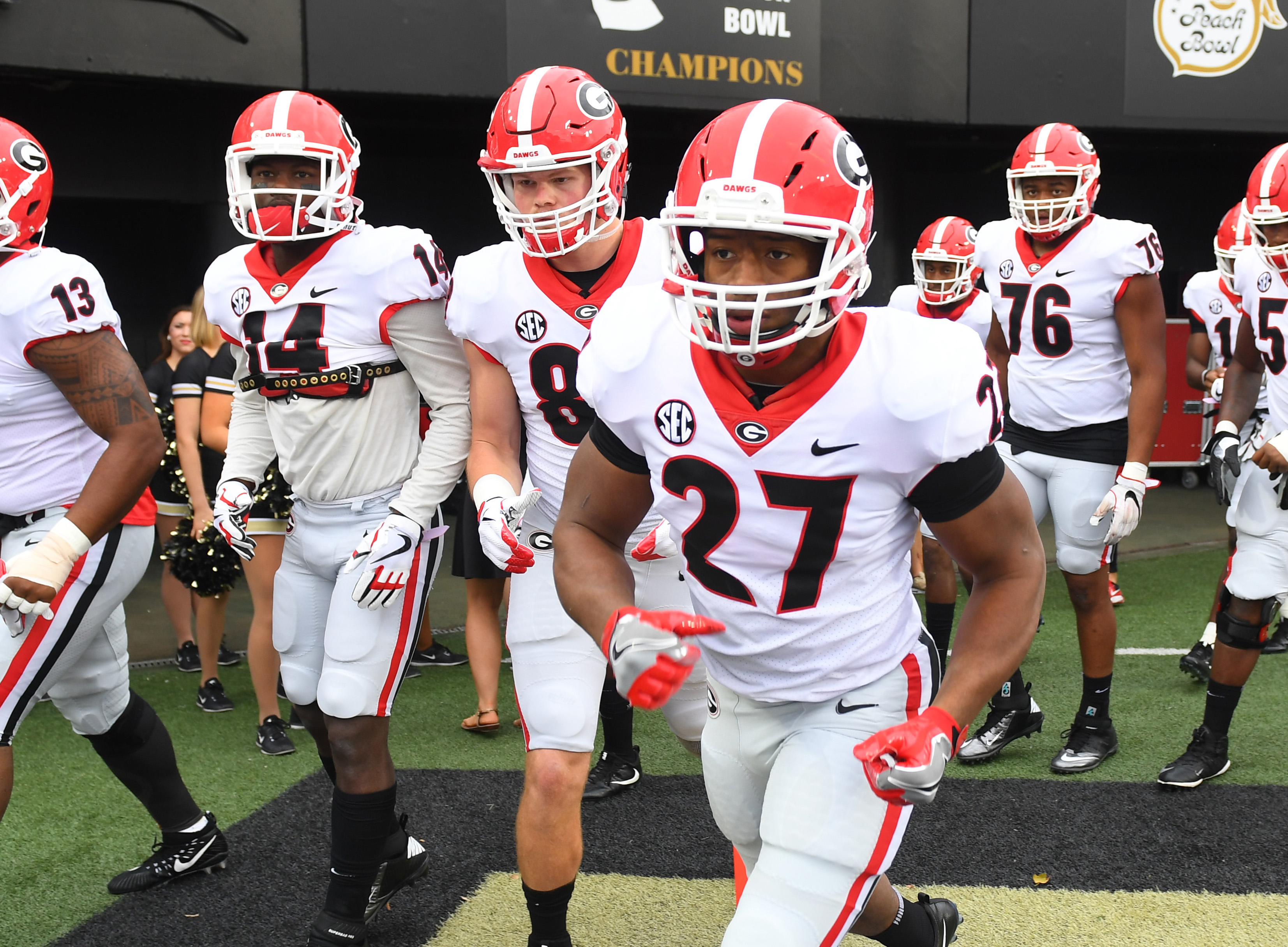
Monday Down South: Another week, another dominant case for Georgia’s staying power as Playoff contender
By Matt Hinton
Published:
Back when he was a fixture on ESPN, Lou Holtz spent a significant chunk of his allotted air time lecturing viewers on his most fundamental rule: In college football, you get a different team every week. It was a trope that could apply in one sense or another to almost every team, every season, and even if you tended to think of “Dr. Lou” as more of a senile uncle than a fount of wisdom, in this case the old hand was onto something.
While we often think of teams as static entities, with predictable strengths and weaknesses, in fact they’re more likely to be wildly unpredictable — even the well-heeled success stories, over the course of a long season, may be prone to close calls, or suffer random lapses no one could have seen coming, or bite the dust against a 31-point underdog for no rhyme or reason.
As often as not championship outfits come to be defined as much by the near-misses as by the blowouts, and the contenders that come up just short do, too. All three winners of the College Football Playoff to date have endured a loss along the way, as have six of the other nine teams that have made the Playoff cut. Over time, a pattern may emerge from the noise; from one Saturday to the next, the prevailing mood is anybody’s guess.
The exceptions to rule — the Alabamas of the world, assembly-line productions built to deliver the same machine-like performance, week-in and week-out — are rare, almost unheard of, and seem even more impressive compared to the up-and-down reality of the rest of the sport. Which brings us, finally, to the team in 2017 most deliberately and (so far) successfully built in Alabama’s image: Georgia, an outfit that has not only achieved a fully realized identity in Kirby Smart’s second season as head coach, but continues to look more like its ideal self with each passing week.
Saturday’s 45-14 romp over Vanderbilt was impressive enough in its own right, for obvious reasons that I’ll expand on a little further down. What was most impressive, though, was just how efficiently it followed the script of the Bulldogs’ wins over Mississippi State and Tennessee, beginning with their complete ownership of the line of scrimmage on both sides of the ball.

Defensively, Smart’s pride and joy has allowed four offensive touchdowns through six games, and just one in the past 12 quarters*; approaching midseason, Georgia ranks third nationally in total defense, second in scoring, and fifth in both rushing and pass efficiency D. (*That’s not counting a 1-yard, garbage-time “drive” by Vanderbilt, set up by a UGA fumble in an otherwise meaningless fourth quarter.)
In advanced-stat terms, it’s first in Defensive FPI and fourth in Defensive S&P+. Offensively, the combination of a road-grading line and a five-deep rotation in the backfield has consistently imposed its will, so much so that freshman quarterback Jake Fromm has barely had an opportunity to exert himself beyond the occasional play-action strike to mostly wide-open receivers on the other side of beleaguered, eight- and nine-man fronts.
Against Vandy, the offense scored on seven of its first eight drives, yielding 45 points in a little over three quarters before letting its foot off the gas — i.e., exactly what a legitimate national contender should do to Vandy, the third week in a row Georgia has dispatched an ostensibly respectable opponent in thorough, Playoff-worthy fashion. The same can be said for their only close call, as well, a 20-19 triumph at Notre Dame in Fromm’s first career start that looks even better now than it did at the time; at the moment, an upset in South Bend is on the short list of the best wins by any team this season, and it was only the first step for a group that’s found its stride over the subsequent month.
Of course, there’s always a chance that what seems obvious in October will come to look shortsighted by December. In Georgia’s case, though, everything we’ve seen over the first half of the season is consistent with the type of team Smart was hired to build, not to mention with the veteran talent across the lineup, and the chances of its early success turning out to be a mirage are exceedingly low: Literally, ESPN’s Football Power Index gives UGA at least an 80 percent chance to beat Missouri (97.3), Florida (81.7), South Carolina (88.2) and Kentucky (93.1) down the stretch, and only slightly less in the season finale at Georgia Tech (73.7).
That leaves only the Nov. 11 trip to Auburn, a toss-up game that ultimately shouldn’t have any bearing on Georgia’s SEC title path if it takes care of its business elsewhere. By then, the bar could be set considerably higher than a trip to Atlanta, which frankly seems like the bare minimum of this outfit’s potential. If the Bulldogs are a different team each week, right now it’s only to the extent that they keep getting better at being themselves.
NOTEBOOK
Around the conference.
Georgia 45, Vanderbilt 14: Vanderbilt stuffed Georgia’s ground game last year, holding the Bulldogs to a grand total of 75 yards rushing en route to a 17-16 upset in Athens that ended with Isaiah McKenzie being stopped short on a decisive fourth down.
Kirby Smart reportedly challenged his offensive line to put Vandy in its rightful place this time around, and the front delivered above and beyond any realistic expectations. On paper, UGA racked up 423 yards on 7.8 per carry — Georgia’s best single-game output on the ground since 1987 — effectively matching Alabama’s devastating rushing turn against the Commodores two weeks ago in similarly team-oriented fashion. (Chubb and Sony Michel combined for 288 yards while still yielding 20 combined carries to backups Elijah Holyfield, D’Andre Swift, and Brian Herrien.) On the field, it was much, much worse.
Some of the holes Georgia’s backs had to run through were downright luxurious. Here’s the lane the left side of the line opened up on Chubb’s first touchdown run …

… which even from an unfavorable camera angle was so expansive the right guard (No. 66 Solomon Kindley) was left searching in vain for someone, anyone in a black uniform, to block.
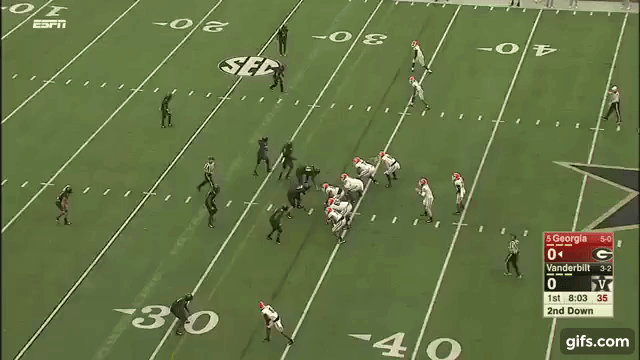
Later on in the first, here’s the left side of the line opening up another considerable seam en rout to a 27-yard gain by Michel …
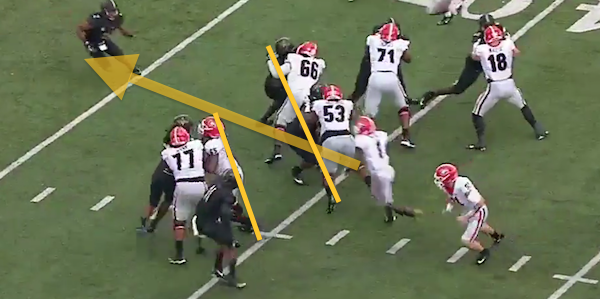
… who more than held up his end by obliterating a brave but helpless safety on the second level. Also watch the double team on this play by LG Kendall Baker (65) and LT Isaiah Wynn (77), which meets a Vandy linebacker at the line of scrimmage and deposits him on his back a good 7 yards downfield:
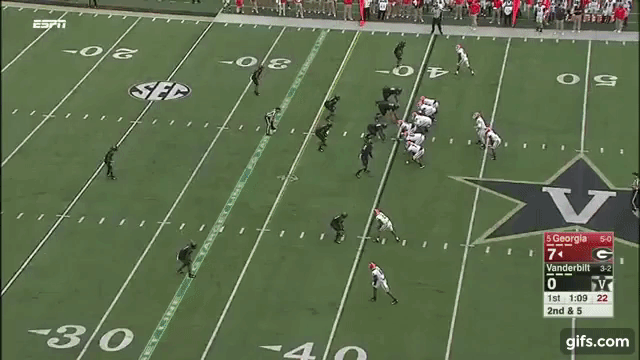
Here’s Chubb in the second quarter, running out of a dead-obvious rushing formation (the Wildcat) on a dead-obvious rushing down (3rd-and-1), and picking up 10 yards with ease …
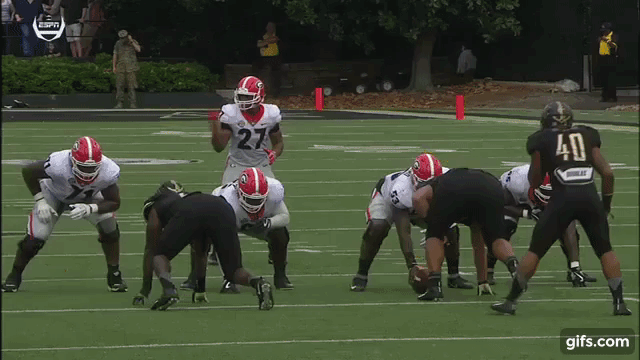
… just a few plays before he sauntered in untouched on what must be the easiest 14-yard touchdown run you’ll ever see against an SEC defense:
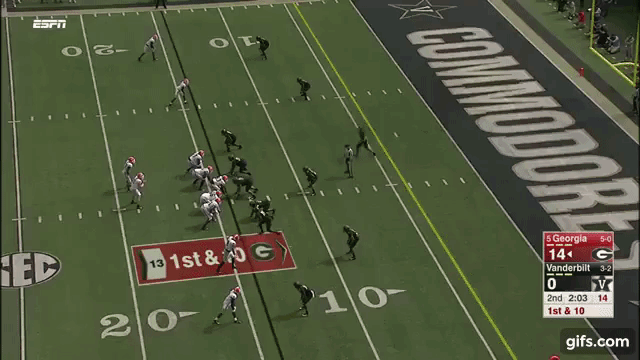
Out of mercy I’ll only include one example from the second half, courtesy of Michel’s 50-yard touchdown run in the third quarter …
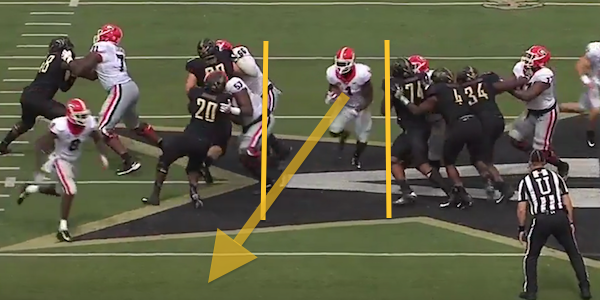
… which at least involved a Vandy lineman laying a finger on him as he burst into the open field, although not much else:
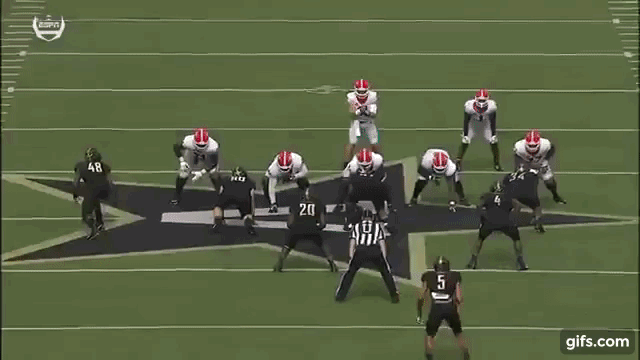
OK, you get the idea: If they’d had a mind to, the Bulldogs could have beaten the Commodores handily without even the pretense of putting the ball in the air. For what it’s worth, Fromm attempted 11 passes, completing seven for 102 yards and two touchdowns — less in the name of winning the game at hand than in getting in a few valuable live reps for a situation when his arm may conceivably be needed. Which might be awhile.
Alabama 27, Texas A&M 19: It wasn’t the result either side wanted, necessarily, but at the end of the day the final score in College Station gave both sides exactly what they needed at midseason. For the Aggies, salvaging a competitive, four-quarter effort from a game they trailed 24-3 in the third was a statement that no, in fact, this team is not about to succumb to another post-Bama collapse. (Kevin Sumlin after the game: “As a team we’ve gotten better every week .… My point is, with these guys if we get better every week there’s not a game that we can’t win.”)
For the Crimson Tide, failing to completely choke the life out of an opponent when they had the chance was a much-needed lesson in the dangers of complacency. (Nick Saban after the game: “I’m trying to get our players to listen to me instead of (the media). All that stuff you write about how good we are? All that stuff they hear on ESPN? It’s like poison. Like rat poison.”)
Don’t let the fact that A&M never actually threatened to overtake the Tide on the scoreboard get in the way of any of that.
If we learned anything, it’s that the Aggies’ defense going forward isn’t necessarily the highly flammable unit that crashed and burned in the season-opening loss at UCLA — relatively speaking, Alabama struggled to gain traction on the ground for the first time since its season opener against Florida State, and in the end more than 40 percent of the Crimson Tide’s total offense came on just three plays.
True, given that one of those plays was a 75-yard touchdown run by Damien Harris, it’s easy to read that line in an “Other than that, Mrs. Lincoln, how was the play?” kind of tone. But before Saturday night, A&M had already delivered one vastly improved defensive effort against South Carolina, and adjusted for degree of difficulty the performance against Bama was at least as impressive. If that becomes the new norm the Aggies really will be good enough to win every time they take the field, whatever the odds say.
Auburn 44, Ole Miss 23: Granted, Ole Miss is all the way in the tank. But this was the third consecutive week that Auburn’s offense looked like a fully realized version of what the preseason optimists anticipated with Jarrett Stidham at the controls — the Tigers scored touchdowns on each of their first five offensive possessions — and if not for the Week 2 debacle at Clemson, almost everything I said in the opening section about Georgia would apply equally to them. In the current three-game stretch, Auburn has scored at least 44 points in all three, on a well-balanced 518 yards per game.
Just like last year, most of that production has come despite a backfield operating at half-strength, at best. Kerryon Johnson missed all of two games (including the loss at Clemson) with a hamstring injury and still isn’t all the way back despite some eye-opening numbers since returning to the lineup.

Meanwhile, Johnson’s comeback coincided with the exit of 240-pound bulldozer Kamryn Pettway, who was marginally effective against Clemson but has hardly played the past three weeks and might miss a few more with a lingering foot injury.
The Tigers are still fourth in the SEC in rushing offense with whoever can go on a given Saturday and liberal dollops of backup Kam Martin as necessary. (Martin has had nagging injury issues of his own.)
If they ever manage to get all of them healthy at the same time, the results could be truly frightening.
LSU 17, Florida 16: In most ways this was indistinguishable from every other hard-hitting, low-scoring, down-to-the-wire LSU-Florida slugfest of the past decade, and in a lot of those years the exact same game could have passed as a true heavyweight struggle.
In context, it just felt like what it was: A couple of good defenses saddled with mediocre-at-best offenses and way too many injuries, just hoping to salvage some hope for a respectable season.
The angry din outside Ed Orgeron’s office window will be a little quieter this week, and Florida’s margin for error in the East Division race is down to zero. But nobody’s about to mistake LSU for an insurgent threat in the West, and on the other side the Gators’ fate still comes down to their next two games against Texas A&M and Georgia.
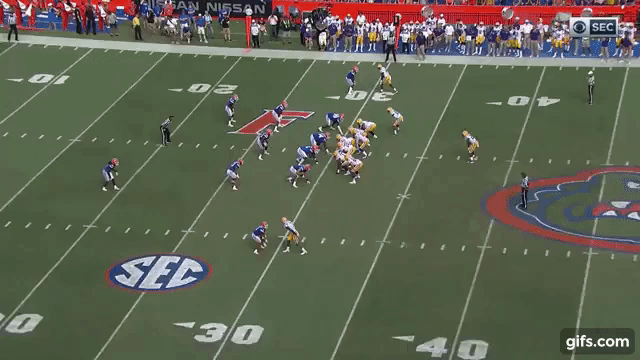
On a more specific note, the win was a the most jet-tastic example yet of first-year LSU offensive coordinator Matt Canada’s obsession with the jet sweep as a core tenet of the offense, and to some extent as a replacement for the conventional running game.
Wide receivers Russell Gage, Derrick Dillon and D.J. Chark logged 10 carries between them Saturday for 105 yards, outrushing tailbacks Derrius Guice (50 yards) and Darrell Williams (35) on barely a third of their attempts. Gage and Dillon broke free for 30-yard gains in the first quarter, the second of which accounted for the game’s first touchdown (see above); for their part, neither Guice nor Williams broke a run that gained more than 9 yards.
Florida’s defense had a lot to do with that, obviously, as did the fact that injuries along the offensive line forced LSU to play most of the game with three true freshman linemen taking their lumps in the front five. (Neither Guice nor Williams was 100 percent, either.) But Canada was hired to run his system, and his ability to manufacture a winning game plan from the jet sweep game when almost nothing else was working may be as convincing a testimonial for his value as a play caller as we see all year.
SUPERLATIVES
The best of the week …
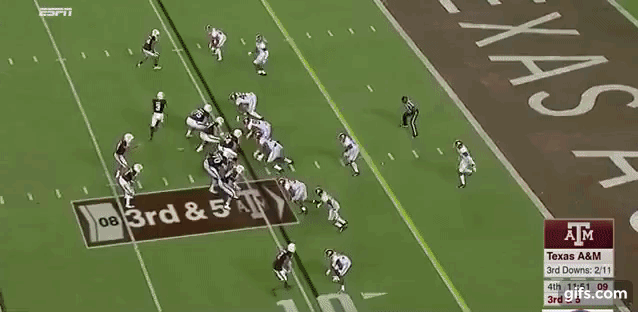
1. Minkah Fitzpatrick, DB, Alabama. If Bama’s jack-of-all-trades nickelback isn’t the SEC’s best player, full stop, he certainly has the most refined flair for the dramatic — even, it turns out, when it entails snuffing any chance of a truly dramatic finish for the Crimson Tide out for good. Against Texas A&M, Fitzpatrick pulled the plug on a frenzied fourth-quarter scene at Kyle Field twice: First by foiling a crucial A&M scoring threat with a diving, third-down interception at the goal line, preserving a two-touchdown lead, and later by recovering the Aggies’ last-ditch onside kick, which he nearly returned for a touchdown in the final seconds.
Those were the highlights of a full night for Fitzpatrick, who was also credited with five tackles, two TFLs, a pass breakup, and a forced fumble on kickoff coverage in addition to 90,000 broken souls. It was his second consecutive game with multiple tackles for loss, leaving him in the team lead in that category for the season.
2. Tyrel Dodson, LB, Texas A&M. On the other side, the Aggies got an inspired effort from Dodson, a true sophomore, who finished with career highs for total tackles (16), solo tackles (10), and tackles for loss (2.5), along with a pair of QB hurries for good measure. All but one of those stops came within 4 yards on the line of scrimmage, and none came on a play that resulted in a first down — all in all, as respectable an effort against the likes of Damien Harris, Bo Scarbrough and Jalen Hurts as anyone has managed the past two years.
3. Kerryon Johnson, RB, Auburn. Johnson said he felt “so close to normal” against Ole Miss after visibly struggling with a hamstring injury throughout September, and looked it, too, from the first series of the game:
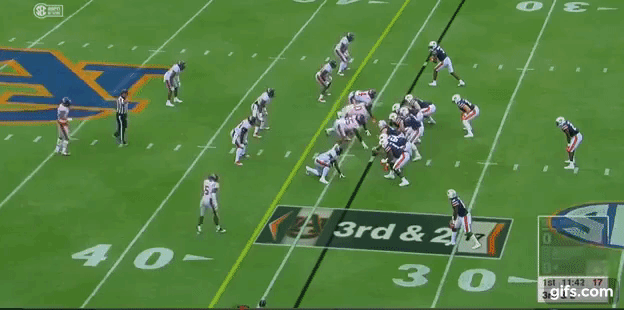
It got easier from there: Altogether, Johnson finished with career highs for yards (204) and carries (28), all of them coming in the first three quarters. He also tacked on three touchdowns, propelling him into the national lead with 12 rushing TDs for the season despite missing two full games. The highlight was a 48-yard sprint in the second quarter on which he burst through the line untouched and left the defense in the dust — a dagger for the reeling Rebels, and a doubly encouraging sight for the home crowd after watching a much gimpier version of their star back get tracked down from behind in the open field in last week’s win over Mississippi State.
4. Chauncey Gardner Jr., DB, Florida. Gardner, another true sophomore, has already earned a reputation for missing tackles at an alarming rate from his starting safety position, and occasionally in embarrassing fashion. (Possibly because he’s a natural cornerback playing out of position due to a preseason injury to Florida’s veteran leader in the secondary, senior Marcell Harris.) Against LSU, though, Gardner was indispensable in run support, finishing with a team-high 12 stops (seven of them solo, none of them on pass plays) and two tackles for loss on a bad ankle.
Just as telling, he wasn’t on the field for the Tigers’ biggest run of the game, a 30-yard jet sweep touchdown by Russell Gage in the first quarter. In all, nine of Gardner’s dozen tackles were within 5 yards of the line of scrimmage.
5. Skai Moore, LB, South Carolina. Moore had a quality-over-quantity kind of afternoon against Arkansas, turning in a stat line that consisted entirely of two tackles for a loss (including a sack), a QB hurry and a pick-six in the third quarter that opened up the floodgates in a 48-22 blowout. That marked the 13th pick of Moore’s decorated career, but the first that’s gone for six.
Catch of the Year of the Week — D.J. Chark, LSU: LSU accomplished very little through the air against Florida, and a significant chunk of what it did produce — nearly 40 percent — was strictly the result of Chark’s determination to wrestle a jump ball heave to open the second half from the hands of the Gators’ Duke Dawson, turning a would-be interception into a 47-yard gain inside the UF 20-yard line:
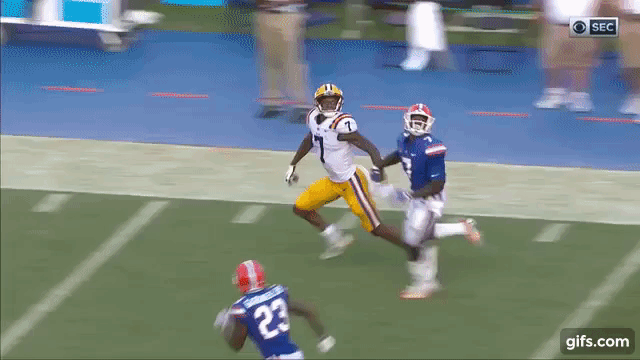
By rule simultaneous possession goes to the offense; with it, LSU proceeded to pay off the big play by punching in its second and final touchdown. The Tigers didn’t cross the 50-yard line again the rest of the game, and didn’t need to.
DEMERITS
… and the worst.
The Last Seconds in Lexington. Missouri trailed Kentucky by six, 40-34, with 29 seconds to play, no timeouts and a fresh set of downs at the UK 28-yard line. On first down, Mizzou QB Drew Lock found J’Mon Moore for a short gain; the play took roughly six seconds off the clock, and because Moore was tackled in bounds the clock continued to run … and run … and run. Between the moment Moore hit the turf and Missouri’s next snap, a full 20 seconds elapsed, thanks mainly to a) A Kentucky defender who appeared to deliberately knock the ball out of Moore’s hands as he hustled to get back to the line, and b) The officials, who took their sweet time retrieving the loose ball and getting it reset while Missouri’s entire offense stood waiting to spike it.
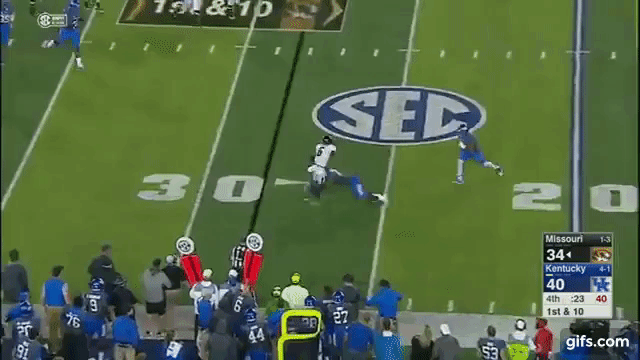
Every part of the sequence was screwed up, beginning with Moore’s failure to get out of bounds in the first place on a play that gained 1 measly yard. Lock’s subsequent pass fell woefully short of the end zone as the clock expired, sealing the Tigers’ fourth consecutive loss.
The whole thing was egregious enough that the SEC felt compelled to issue a statement Sunday confirming that, well, yes, the officials should have noticed that the ball was knocked out of Moore’s hands and stopped the clock with 16 seconds left, ostensibly leaving the Tigers with time for more than one desperate heave. Sorry about that! (And thank God this didn’t happen in a game anyone outside of the respective fan bases happened to be watching ….)
Ole Miss, In General. Sure, Auburn’s good, maybe very good. Alabama’s great. It’s bad scheduling luck that the Rebels wound up opening up conference play with the class of the West Division, both on the road, in consecutive weeks, saddled with an interim coaching staff and nothing in particular to play for. But getting outscored 110-26 with a roster built through a succession of Top-25 recruiting classes is way beyond bad luck. It’s a sign of a team that looks like it’s given up.
Florida’s Botched PAT. The Gators mounted back-to-back touchdown drives in the third quarter covering 75 and 76 yards, respectively, easily the best the UF offense has looked this season against a defense that isn’t Vanderbilt’s. Together, they pulled Florida within an extra point of tying LSU, 17-16, at which point the momentum ground to an abrupt halt.
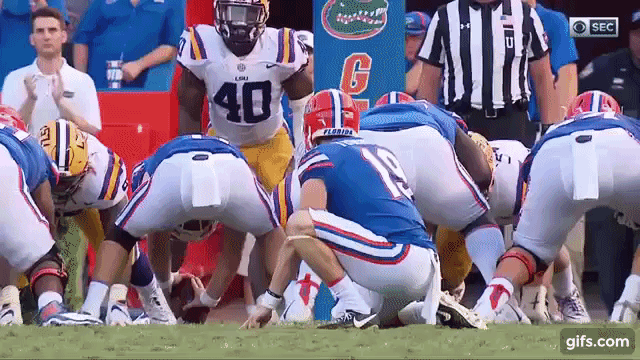
These things happen, of course, except in Eddy Piñeiro’s case, they kinda don’t: Prior to that miss, Piñeiro was 46-of-46 on extra-point attempts at Florida and 8-for-8 on field goals from 30 yards and in. On almost all of them All-SEC punter Johnny Townsend has served as the holder, without incident, until for no apparent reason the ball suddenly slipped out of his hand on the tying PAT just before Piñeiro’s foot made contact. Townsend spun the laces out and they kept spinning.
The gaffe was completely random, inexplicable, and after the offense reverted to its usual, stagnant form in the fourth quarter, ultimately the difference between overtime and defeat. For all the toss-up games Jim McElwain has somehow managed to win in Gainesville, a routine bust involving arguably the two most automatic players on the team may have been the most unlikely way possible for the coin to finally come up tails.
Matt Hinton, author of 'Monday Down South' and our resident QB guru, has previously written for Dr. Saturday, CBS and Grantland.
